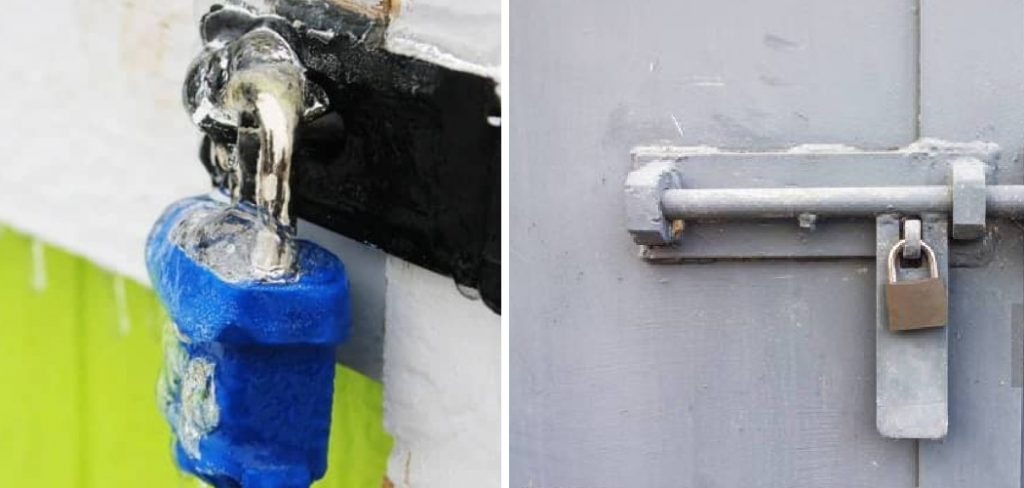Have you ever been in a situation where you needed to access something only to realize that the padlock had frozen shut? If so, then this blog post is for you! Being able to unfreeze a padlock can save time and stress. It’s fairly simple if you follow the right procedure.

Whether you’re dealing with a frozen padlock due to a change in temperature or moisture, here are some tips on how to unfreeze padlock. Always approach a padlock cautiously and use protective equipment such as gloves, safety glasses, and dust masks if necessary.
In this blog post, we will share some tips on the easiest way to open your frozen padlock. Read on for more information about what tools and techniques could help restore easy access!
What Will You Need?
Before you can unfreeze a padlock, you must gather some supplies. Prepare the following items:
- Silicone spray or WD-40
- Heat source (lighter or blow dryer)
- A rag/towel
- Gloves and safety glasses (optional)
Once you have gathered your supplies, you can unfreeze the padlock.
10 Easy Steps on How to Unfreeze Padlock
Step 1: Apply a Lubricant
The first step in unfreezing the padlock is to apply a lubricant such as silicone spray or WD-40. Spray the lubricant directly onto the frozen metal parts of the lock, ensuring it penetrates the mechanisms. This will help to reduce the friction and loosen parts that are stuck.
Step 2: Use a Heat Source

Use a heat source such as a lighter or a blow dryer to increase the temperature of the padlock, focusing on areas where lubricant was applied. Be sure not to overheat it, as this may cause more damage. Additionally, make sure that the heat source is not too close to the padlock, as it may cause it to melt.
Step 3: Tap Gently
After warming the lock, gently tap the sides of the padlock with a light hammer or similar tool. This is to help the lubricant penetrate deeper into the lock mechanism. Be careful not to apply too much force as it may cause damage to the lock.
Step 4: Apply More Lubricant and Heat
At this stage, apply another round of lubricant to the padlock and use your heat source again. The additional lubricant and heat will help to further loosen the frozen parts of the lock. Remember not to overheat or apply too much lubricant, as excessive amounts could cause additional problems.
Step 5: Try to Open the Padlock

Now, attempt to open the padlock with the key or combination. If the padlock doesn’t open, don’t force it. Instead, repeat the previous steps. If the padlock remains frozen after several attempts, you might have to consider seeking professional help.
These steps provide a simple and safe approach to unfreeze a padlock. Always remember to handle the tools and the padlock with care to avoid damage or injury.
Step 6: Allow Time for Thawing
If the padlock still does not open after several attempts, it might be helpful to let it sit for a while to allow time for thawing. The combination of heat and lubricant will continue to loosen the frozen components. You can then attempt to open it again after some time. If the padlock remains frozen, repeat the steps above as necessary. It’s important to maintain patience and take your time to avoid damaging the padlock.
Step 7: Use Hot Water
If you still cannot open the padlock, consider using hot water to unfreeze it. Fill a container with hot water, ensuring it does not exceed 140°F (60°C). Place the padlock in the container and leave it to soak for a few minutes. This should soften the metal on the padlock and help to unfreeze it.
Step 8: Clear any Ice or Water from the Lock
After you’ve opened the padlock, make sure to clear away any ice or water that may have gotten into the lock mechanisms. Use a rag or towel to wipe away the moisture. This will help to prevent future freezing issues.
Step 9: Apply a Rust Inhibitor
Once you have cleared away any water or ice, use a rust inhibitor such as WD-40 to coat the padlock mechanisms. This will help protect it from further corrosion and make sure that it stays operational for longer periods of time. Additionally, storing the padlock in a dry and cool environment when not in use is important.
Step 10: Replace the Padlock If Necessary
It’s possible that even after all these steps, your padlock may still be stuck. If this is the case, you should consider replacing it with a new one. This is the best way to guarantee that your padlock will remain functional and durable in the long run.

Following these simple steps, you can easily unfreeze a padlock and get back to whatever task. Always take your time and use the right tools when working with any padlocks. You can open up a frozen padlock like a pro with the right approach!
5 Additional Tips and Tricks
- If your padlock is frozen due to extreme weather conditions, gently use a hair dryer to thaw out the lock. Keep it on low heat and move the hair dryer around all sides of the lock until it unfreezes.
- Rubbing alcohol can be used to lubricate a frozen padlock. Simply apply a small amount of rubbing alcohol with a cotton swab, moving it around the mechanism until the lock is unfrozen.
- If your padlock is still frozen despite trying these methods, try putting it in a sealed plastic bag and placing it in warm/hot water for about 15-30 minutes. This should help to thaw out the lock without damaging it.
- Ensure that your padlock is properly lubricated to prevent it from freezing in the future. Use a lubricant specifically designed for locks and apply it every few months or as needed.
- If all else fails, you should consult a professional locksmith who can help you unfreeze your padlock without damaging it in any way.
With these tips and tricks, you can easily unfreeze your padlock so that you can use it again! And remember to keep your lock properly lubricated at all times – this will help prevent any further issues or freezing in the future.
5 Things You Should Avoid

- Do not attempt to unfreeze your padlock using any type of solvent, as this can damage the mechanism.
- Never use a heat source such as a blow torch or other device with an open flame to try and thaw out the lock – this is incredibly dangerous and could lead to serious injury or property damage.
- Do not force the padlock’s shack, as this could break it and render the lock useless.
- Don’t be tempted to use a lubricant that is not specifically designed for locks, as this could damage the internal mechanics of your padlock and cause further issues.
- Avoid using any type of tool or force to try and open the lock – if you do, you may end up damaging the lock beyond repair and having to replace it.
These simple precautions allow you to unfreeze your padlock without any further issues.
Can Temperature Affect Locks?
Yes, extreme temperatures can cause locks to freeze and become difficult or even impossible to open. This is because the internal lubricants and mechanisms in locks can get stuck together due to ice or cold weather, making it hard for them to move.
It’s important to remember this when you’re storing your padlock outside or in a place where temperature fluctuations occur and to take the necessary precautions to ensure that your lock remains functional. Make sure to lubricate it regularly and store it in a place with a stable temperature, or consider using an insulated padlock designed for cold weather.
By following these tips, you can ensure that your padlock stays in good condition, even during extreme temperatures.
Conclusion
In short, unfreezing a padlock is straightforward, provided the right tools and techniques are employed. Heat is often the most reliable option for releasing a frozen lock mechanism, as this will slowly cause the ice to melt away and allow full access to the contents. However, if heat does not work or is inaccessible, then cutting it open using appropriate tools is a last resort.
In any case, it’s always best to remember your combinations or have multiple spare keys handy so that in any future situation, you can avoid having to go through the trouble of opening your lock via these methods. All in all, carefully addressing your current padlock problems while preventing future ones is key to keeping your valuables safe and secure!
Hopefully, the article on how to unfreeze padlock has been useful for you! By following the tips and tricks discussed here, you should be able to free your padlock from any frozen state easily. Always remember to be mindful of temperature fluctuations and to regularly lubricate your lock so that it remains functional no matter what the weather throws at it. Thanks for reading!
About
Safety Fic is a distinguished figure in the world of Diy design, with a decade of expertise creating innovative and sustainable Diy solutions. His professional focus lies in merging traditional craftsmanship with modern manufacturing techniques, fostering designs that are both practical and environmentally conscious. As the author of diy, Safety Fic delves into the art and science of Safety Fic-making, inspiring artisans and industry professionals alike.
Education RMIT University
(Melbourne, Australia) Associate Degree in Design (Safety Fic) Focus on sustainable design, industry-driven projects, and practical craftsmanship. Gained hands-on experience with traditional and digital manufacturing tools, such as CAD and CNC software.
Nottingham Trent University
(United Kingdom) Bachelor’s in diyfastly.com and Product Design (Honors) Specialized in product design with a focus on blending creativity with production techniques. Participated in industry projects, working with companies like John Lewis and Vitsoe to gain real-world insights.
Publications and Impact
In diy, Safety Fic his insights on indoor design processes, materials, and strategies for efficient production. His writing bridges the gap between artisan knowledge and modern industry needs, making it a must-read for both budding designers and seasoned professionals.
